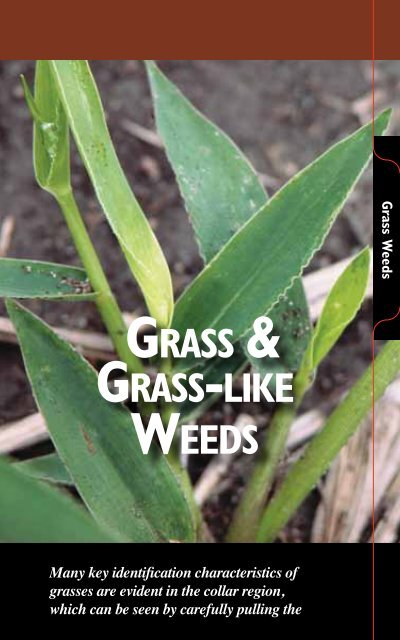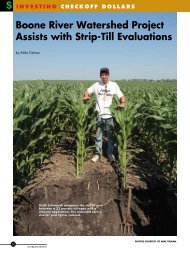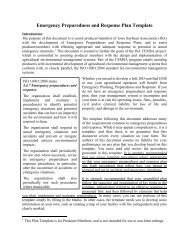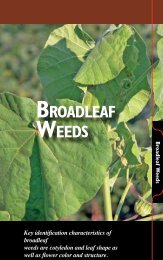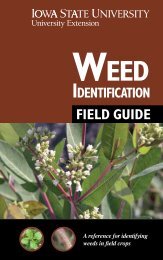grass & grass-lIke Weeds - The Iowa Soybean Association
grass & grass-lIke Weeds - The Iowa Soybean Association
grass & grass-lIke Weeds - The Iowa Soybean Association
You also want an ePaper? Increase the reach of your titles
YUMPU automatically turns print PDFs into web optimized ePapers that Google loves.
<strong>grass</strong> &<br />
<strong>grass</strong>-<strong>lIke</strong><br />
<strong>Weeds</strong><br />
Many key identification characteristics of<br />
<strong>grass</strong>es are evident in the collar region,<br />
which can be seen by carefully pulling the<br />
Grass <strong>Weeds</strong>
Grass MorpHoloGy<br />
12<br />
Basic structure of <strong>grass</strong> shoot<br />
Collar<br />
Leaf blade<br />
Leaf sheath<br />
ligule types<br />
Close-up of collar region<br />
Midvein<br />
Leaf blade<br />
Ligule<br />
Auricle<br />
Ligule absent Ligule hairy Ligule membranous<br />
Weed IdenTIfICaTIon fIeld GuIde<br />
Sheath
IdenTIfICaTIon Key<br />
ligule absent<br />
round stem<br />
leaves not <strong>grass</strong>-like leaves <strong>grass</strong>-like<br />
whorled<br />
branches<br />
resembles<br />
miniature<br />
pine tree,<br />
< 2’ tall<br />
little to no<br />
branching<br />
stem is a tube,<br />
hollow between<br />
joints<br />
Field horsetail Scouringrush<br />
leaves rough on<br />
both surfaces,<br />
stem usually<br />
tinged purple at<br />
base<br />
Barnyard<strong>grass</strong><br />
triangular stem<br />
yellow-green,<br />
shiny blades<br />
Yellow nutsedge<br />
Weed IdenTIfICaTIon fIeld GuIde 13
IdenTIfICaTIon Key<br />
blades and<br />
sheaths<br />
covered with<br />
very short,<br />
dense hairs<br />
14<br />
one leaf<br />
margin<br />
usually<br />
crinkled<br />
Woolly<br />
cup<strong>grass</strong><br />
blade hairy on upper<br />
and lower surface<br />
leaf blade with<br />
many hairs<br />
blades and<br />
sheaths covered<br />
with long hairs<br />
prominent<br />
white<br />
midvein<br />
Witch<strong>grass</strong><br />
very short,<br />
stiff hairs<br />
ligule hairy<br />
blade hairy only<br />
on upper surface<br />
sheath margins<br />
often transparent;<br />
seed is a large,<br />
spiny bur<br />
Longspine<br />
sandbur<br />
Weed IdenTIfICaTIon fIeld GuIde<br />
fine,<br />
dense hairs<br />
very short<br />
hairs on<br />
sheath<br />
margins<br />
Giant<br />
foxtail
IdenTIfICaTIon Key<br />
a few long<br />
hairs on blade<br />
near collar region<br />
sheath flat,<br />
margins hairless,<br />
often reddish<br />
near base<br />
Yellow foxtail<br />
no prominent<br />
midvein<br />
leaf blade with few or no hairs<br />
no hairs<br />
on blade<br />
sheath<br />
margins<br />
hairy<br />
Green foxtail<br />
prominent<br />
midvein<br />
sheath margins<br />
usually hairless;<br />
swollen nodes<br />
Fall panicum<br />
Weed IdenTIfICaTIon fIeld GuIde 15
IdenTIfICaTIon Key<br />
16<br />
leaf blade and sheath<br />
hairless to sparsely hairy<br />
long, narrow<br />
leaf blades<br />
blade rough;<br />
midrib not<br />
white or<br />
prominent<br />
Wirestem<br />
muhly<br />
auricles absent<br />
short, broad<br />
leaf blades<br />
flat stem; sheaths<br />
white at base<br />
midrib white<br />
above, prominent<br />
below<br />
Shattercane<br />
ligule membranous<br />
short, scaly<br />
rhizomes no rhizomes<br />
Goose<strong>grass</strong><br />
blade with pronounced<br />
blade smooth ridges on upper surface<br />
Weed IdenTIfICaTIon fIeld GuIde<br />
narrow<br />
(< 1 /2” wide),<br />
upright leaves<br />
Foxtail barley
IdenTIfICaTIon Key<br />
leaf blade and sheath hairy<br />
sheath<br />
overlapping<br />
stems may<br />
root at nodes<br />
sheath<br />
fused<br />
leaves have<br />
distinctive twist<br />
auricles present<br />
long, clasping<br />
auricles<br />
prominent<br />
rhizomes<br />
short, claw-like<br />
auricles<br />
no rhizomes;<br />
prominent<br />
leaf veins<br />
Large crab<strong>grass</strong> Downy Quack<strong>grass</strong> Italian<br />
brome<br />
rye<strong>grass</strong><br />
Weed IdenTIfICaTIon fIeld GuIde 17
sedGe faMIly (CyperaCeae)<br />
Yellow nutsedge<br />
Other names: Yellow nut<strong>grass</strong>, chufa<br />
Scientific name: Cyperus esculentus<br />
life cycle/height: Perennial, up to 2 feet<br />
leaves: Shiny, yellow-green and hairless<br />
with a distinct ridge along the midvein.<br />
Leaves are produced in groups of 3 at the<br />
base of the plant. No nodes are present.<br />
ligules: None<br />
Stems: Erect, unbranched and 3-sided;<br />
triangular cross section. Rhizomes are wiry<br />
and scaly with nutlike tubers produced at<br />
the tips.<br />
Seedhead: Inflorescence is a cluster of<br />
yellow-brown spikes at the end of a<br />
solitary stem.<br />
Comments: Reproduces by seed,<br />
rhizomes and tubers. Prefers poorly<br />
drained soils.<br />
Yellow nutsedge plants<br />
18<br />
Yellow nutsedge seedhead<br />
Tuber<br />
Yellow nutsedge root system<br />
Weed IdenTIfICaTIon fIeld GuIde
HorseTaIl faMIly (equisetaCeae)<br />
Field horsetail<br />
spore- producing<br />
Field horsetail<br />
whorled branches<br />
Field horsetail<br />
vegetative stem<br />
Field horsetail<br />
Other names: Common horsetail, monkey puzzle,<br />
bottle brush<br />
Scientific name: Equisetum arvense<br />
life cycle/height: Perennial, up to 2 feet<br />
leaves: Small, scale-like and fused into sheaths around<br />
stems. Sheaths of spore-producing stems are light brown<br />
with 8 to 12 large, pointed, dark brown teeth; sheaths of<br />
vegetative stems are green with 10 to 12 black teeth.<br />
ligules: None<br />
Stems: Spore-producing stems appear in early to<br />
mid-spring and are short lived. <strong>The</strong>y are unbranched,<br />
whitish to light brown, usually thick and succulent and<br />
6 to 12 inches tall. Vegetative stems are green with<br />
whorls of 10 to 12 ridged branches at each joint.<br />
Vegetative plants resemble miniature pine trees.<br />
Seedhead: Spore-bearing cones on the ends of fertile<br />
stems are up to 1 inch long, oblong and rounded at the<br />
top. Cones are mostly brown and covered with sporebearing<br />
tubercles that have black and white markings.<br />
Comments: Reproduces by spores, rhizomes and<br />
tubers. Tolerant to most herbicides, including<br />
glyphosate. Found in poorly drained areas and is an<br />
increasing problem in no-till fields.<br />
Field horsetail plants in no-till field<br />
Weed IdenTIfICaTIon fIeld GuIde 19
HorseTaIl faMIly (equisetaCeae)<br />
Scouringrush<br />
Other names: Snake<strong>grass</strong>, pop<strong>grass</strong><br />
Scientific name: Equisetum hyemale<br />
life cycle/height: Perennial, up to 4 feet<br />
leaves: Ring-like sheaths up to 1 inch long at<br />
the top of each joint. Sheaths have a whitish-gray,<br />
brown or tan middle section and a black rim with<br />
up to 40 small, black teeth that may break off.<br />
ligules: None<br />
Stems: Erect, evergreen, rigid, jointed and<br />
segmented with 10 to 40 fine ridges running<br />
lengthwise. Lower joints are spaced several inches<br />
apart; joints become closer together higher on<br />
the stem. Stems are hollow between joints. Sporeproducing<br />
stems look like vegetative stems, except<br />
they end in a spore-bearing cone. Rhizomes with<br />
fibrous secondary roots are black, round and may<br />
have tubers.<br />
Seedhead: Spore-bearing cones are tan to<br />
brown, up to 1 inch long, oblong and pointed at<br />
the top.<br />
Comments: Reproduces by spores, rhizomes<br />
and tubers. Tolerant to most herbicides, including<br />
glyphosate. Increasing problem in no-till fields.<br />
Scouringrush sporeproducing<br />
20<br />
Weed IdenTIfICaTIon fIeld GuIde<br />
Scouringrush stem joint<br />
Scouringrush spore-bearing<br />
cone<br />
Scouringrush vegetative stems<br />
Ridges
Grass faMIly (poaCeae)<br />
Downy brome collar<br />
region<br />
Downy brome seedhead<br />
Downy brome young plant<br />
downy brome<br />
Other names: Drooping brome<br />
Scientific name: Bromus tectorum<br />
life cycle/height: Early summer or winter<br />
annual, up to 2 feet<br />
leaves: Blades and sheaths are densely covered<br />
with soft hairs. Leaves have a distinctive twist.<br />
Sheaths are fused, not overlapping.<br />
ligules: Membranous, toothed or fringed with<br />
hair up to 1 /8 inch long<br />
Stems: Clump-forming, erect or spreading and<br />
hairless to slightly hairy<br />
Seedhead: Inflorescence is a 2 to 8 inch long<br />
drooping panicle, often turning purple near maturity.<br />
Individual spikelets are 3 /4 to 1 1 /2 inches long, tipped<br />
with about 1 /2 inch long awns.<br />
Comments: Reproduces by seed. Resembles<br />
cheat (Bromus secalinus), but cheat is considerably<br />
less hairy throughout. Downy brome and cheat are<br />
found in overgrazed pastures and are an increasing<br />
problem in no-till fields.<br />
Weed IdenTIfICaTIon fIeld GuIde 21
Grass faMIly (poaCeae)<br />
longspine sandbur<br />
Other names: Bur<strong>grass</strong>, field sandbur<br />
Scientific name: Cenchrus longispinus<br />
life cycle/height: Annual, up to 2 feet<br />
leaves: Blades are flat, narrow, up to 8 inches long with very short, stiff<br />
hairs on upper surfaces that give them a rough texture. Hairs may only be<br />
visible with a hand lens. Lower leaf surface is hairless. Leaf margins are rough.<br />
Sheaths are mostly hairless but a few hairs may occur on the margins. Sheath<br />
margins are split part way up the stem.<br />
ligules: Hairy, less than 1 /10 inch long<br />
Stems: Hairless and mostly covered by the leaf sheaths<br />
Seedhead: Inflorescence consists of 4 to 20 round, spiny burs attached by<br />
short stems to 4 inch long zigzag stalks. Inflorescences are sometimes partly<br />
enclosed by upper leaves. Burs are hairy and have spines up to 1 /4 inch long.<br />
Burs contain 2 to 4 seeds that are each about 1 /5 inch long.<br />
Comments: Reproduces by seed. Germinates late, commonly found on field<br />
edges or in fields with sandy soils.<br />
Longspine sandbur seedhead<br />
Longspine sandbur burs Longspine sandbur<br />
plants<br />
22<br />
Weed IdenTIfICaTIon fIeld GuIde
Grass faMIly (poaCeae)<br />
Large crab<strong>grass</strong><br />
Large crab<strong>grass</strong> collar region<br />
Large crab<strong>grass</strong> seedhead<br />
large crab<strong>grass</strong><br />
Other names: Hairy crab<strong>grass</strong>, purple<br />
crab<strong>grass</strong><br />
Scientific name: Digitaria sanguinalis<br />
life cycle/height: Annual, up to 3 feet<br />
leaves: Both leaf surfaces and sheath are<br />
hairy. Leaves are up to 8 inches long and<br />
often wider than most <strong>grass</strong>es. Sheaths are<br />
overlapping.<br />
ligules: Membranous, jagged, 1 /10 inch long<br />
Stems: Erect or spreading, hairless and<br />
may root at nodes that contact ground<br />
Seedhead: Inflorescence is a terminal<br />
panicle consisting of 3 to 10 slender,<br />
finger-like branches. Branches appear<br />
whorled. Seeds are yellow-brown, 1 /10 inch<br />
long and arranged alternately on branches<br />
of the inflorescence.<br />
Comments: Reproduces by seed.<br />
Emerges later than most annual <strong>grass</strong><br />
weeds and grows well under hot, dry<br />
conditions. Smooth crab<strong>grass</strong> (Digitaria<br />
ischaemum) is similar to large crab<strong>grass</strong> but<br />
does not have hairs on the leaf blades or<br />
sheaths, and is not as robust or tall.<br />
Large crab<strong>grass</strong> plant<br />
Weed IdenTIfICaTIon fIeld GuIde 23
Grass faMIly (poaCeae)<br />
Barnyard<strong>grass</strong><br />
Other names: Japanese millet, water<strong>grass</strong><br />
Scientific name: Echinochloa crus-galli<br />
life cycle/height: Annual, up to 4 feet<br />
leaves: Up to 20 inches long and 1inch<br />
wide and predominantly hairless, except<br />
for occasional hairs at leaf bases. Leaves<br />
are rough on both surfaces with a distinct<br />
white midvein.<br />
ligules: Absent<br />
Stems: Erect, thick, flattened, hairless and<br />
tinged red to maroon at the base<br />
Seedhead: Inflorescence is an upright<br />
to nodding terminal panicle up to 10<br />
inches long. Panicles have compact, thick,<br />
green to purple side branches that have<br />
individual spikelets each with a short,<br />
stiff, terminal awn. Seeds are brown or<br />
maroon.<br />
Comments: Reproduces by seed.<br />
Prefers wet areas.<br />
Barnyard<strong>grass</strong> plant base tinged red to maroon<br />
24<br />
Barnyard<strong>grass</strong> collar region<br />
Barnyard<strong>grass</strong> seedhead<br />
Weed IdenTIfICaTIon fIeld GuIde
Grass faMIly (poaCeae)<br />
Goose<strong>grass</strong> collar region<br />
Folded leaf blade<br />
Goose<strong>grass</strong> leaves<br />
Goose<strong>grass</strong><br />
seedhead<br />
Hairs<br />
Goose<strong>grass</strong><br />
Other names: Crowsfoot <strong>grass</strong>, silver<br />
crab<strong>grass</strong>, wire<strong>grass</strong><br />
Scientific name: Eleusine indica<br />
life cycle/height: Annual, up to 1 1 /2 feet<br />
leaves: Blades are up to 12 inches long<br />
and folded along the midvein. Blades and<br />
sheaths are hairless or sparsely hairy<br />
except for long hairs near the collar<br />
region. Sheaths are flattened and white<br />
at the base.<br />
ligules: Membranous, uneven and less<br />
than 1 /10 inch long<br />
Stems: Prostrate to occasionally erect<br />
with a distinctive white center at the base<br />
Seedhead: Inflorescence is composed<br />
of 2 to 13 spikes in finger-like clusters at<br />
tops of stems. Each spike is 1 to 6 inches<br />
long. <strong>The</strong>re may be 1 or 2 individual spikes<br />
lower on the stem. Two rows of flattened<br />
spikelets occur along each spike.<br />
Comments: Reproduces by seed.<br />
Goose<strong>grass</strong> plant base with white center<br />
Weed IdenTIfICaTIon fIeld GuIde 25
Grass faMIly (poaCeae)<br />
Quack<strong>grass</strong><br />
Other names: Couch<strong>grass</strong><br />
Scientific name: Elymus repens<br />
life cycle/height: Perennial, up to 4 feet<br />
leaves: Up to 10 inches long. May have a few<br />
hairs on the upper surface; lower surface is<br />
hairless. Leaves have narrow auricles that clasp<br />
the stem. Auricles may not be present on<br />
mature leaves.<br />
ligules: Membranous, about 1 /32 inch long<br />
Stems: Erect and often bending out and up<br />
from the base of the plant. Plants spread by thin,<br />
yellowish to white, sharp-tipped rhizomes that<br />
may reach up to 3 1 /2 feet long.<br />
Seedhead: Inflorescence is a 2 to 8 inch long,<br />
narrow spike consisting of many individual<br />
spikelets arranged in 2 rows along the stem.<br />
Individual spikelets have prominent awns.<br />
Seedheads look like slender wheat seedheads.<br />
Comments: Reproduces by seed and rhizomes.<br />
Typically the first <strong>grass</strong> to emerge in crop fields,<br />
normally occurring in distinct patches. Often<br />
found in wet areas and is an increasing problem<br />
in no-till fields. It is a noxious weed in <strong>Iowa</strong>.<br />
Quack<strong>grass</strong> plants<br />
26<br />
Weed IdenTIfICaTIon fIeld GuIde<br />
Auricles<br />
Quack<strong>grass</strong> leaf and stem<br />
Quack<strong>grass</strong> seedhead and<br />
leaves<br />
Rhizomes
Grass faMIly (poaCeae)<br />
Woolly cup<strong>grass</strong><br />
Other names: Hairy cup<strong>grass</strong><br />
Scientific name: Eriochloa villosa<br />
life cycle/height: Annual, up to 3 feet<br />
leaves: <strong>The</strong> first leaf is wide and<br />
typically lies flat just above the soil<br />
surface. Upper and lower surfaces of<br />
leaf blades and sheath are covered with<br />
fine, dense, very short hairs (use a hand<br />
lens to help see hairs). One leaf margin<br />
is usually crinkled.<br />
ligules: Hairy, about 1 /16 inch long<br />
Stems: Erect or occasionally decumbent<br />
and rooting at lower nodes. Stem<br />
is covered with short, soft hairs.<br />
Seedhead: Inflorescence is covered<br />
with soft hairs and has 1 or 2 rows of<br />
large, 1 Woolly cup<strong>grass</strong> seedling<br />
/5 inch long seeds on finger-like<br />
Woolly cup<strong>grass</strong> seedhead branches. Each seed is nestled in a<br />
hairy “cup.”<br />
Comments: Reproduces by seed. It typically emerges 7 to 10 days prior to<br />
the foxtails. Seedlings resemble large crab<strong>grass</strong> (page 23), but hairs on large<br />
crab<strong>grass</strong> are considerably longer. Woolly cup<strong>grass</strong> seeds are relatively large<br />
and may remain attached to the roots when plants are dug from the soil.<br />
Woolly cup<strong>grass</strong> is difficult to control with soil-applied herbicides.<br />
Woolly cup<strong>grass</strong> leaves<br />
Crinkled<br />
margin<br />
Weed IdenTIfICaTIon fIeld GuIde 27
Grass faMIly (poaCeae)<br />
Foxtail barley<br />
Other names: Squirreltail<br />
Scientific name: Hordeum jubatum<br />
life cycle/height: Perennial, up to 2 feet<br />
leaves: Flat, stiff, upright with pronounced<br />
ridges on upper surfaces and 2 to 6 inches<br />
long. Blades and sheaths are hairless or<br />
sparsely hairy.<br />
ligules: Membranous, about 1 /32 inch long<br />
Stems: Erect, stiff, hollow, hairless and<br />
clump forming<br />
Seedhead: Inflorescence is a nodding,<br />
2 to 4 inch long (excluding awns) bristly<br />
spike, sometimes partially enclosed<br />
in upper sheaths. Awns are 1 to 3<br />
inches long.<br />
Comments: Reproduces by seed. Plants<br />
may appear bluish-green. May be more<br />
problematic in no-till fields.<br />
Foxtail barley plants<br />
28<br />
Foxtail barley collar region<br />
Foxtail barley seedhead<br />
Weed IdenTIfICaTIon fIeld GuIde<br />
Ridges
Grass faMIly (poaCeae)<br />
Prominent<br />
veins<br />
Auricles<br />
Italian rye<strong>grass</strong> collar region<br />
Attached<br />
edgewise<br />
Italian rye<strong>grass</strong> spikelets<br />
Italian rye<strong>grass</strong> plants<br />
italian rye<strong>grass</strong><br />
Other names: Annual rye<strong>grass</strong><br />
Scientific name: Lolium multiflorum<br />
life cycle/height: Annual, up to<br />
3 feet<br />
leaves: Up to 8 inches long with<br />
narrow, claw-like auricles. <strong>The</strong> upper<br />
surface is dull with prominent veins;<br />
the lower surface is glossy. Sheaths are<br />
hairless.<br />
ligules: Membranous, less than 1 /10<br />
inch long<br />
Stems: Erect and often tinged red or<br />
purple at the base<br />
Seedhead: Inflorescence is a 4 to 16<br />
inch long spike with spikelets arranged<br />
alternately along the stem. Each spikelet<br />
is attached edgewise to the central<br />
stem. <strong>The</strong> lower bract enclosing each<br />
seed in the spikelet usually has an awn<br />
up to 1 /3 inch long.<br />
Comments: Reproduces by seed.<br />
More prevalent in no-till fields.<br />
Weed IdenTIfICaTIon fIeld GuIde 29
Grass faMIly (poaCeae)<br />
Wirestem muhly<br />
Other names: Common satin <strong>grass</strong><br />
Scientific name: Muhlenbergia frondosa<br />
life cycle/height: Perennial, up to 3 feet<br />
leaves: Blades are 2 to 4 inches long,<br />
broadest near the middle, rough and<br />
hairless. Sheaths are hairless.<br />
ligules: Membranous, about 1 /32 inch long<br />
Stems: Plants have a dense, bushy<br />
appearance. Stems are hairless, stiff and<br />
erect early, becoming decumbent later. Stems<br />
often form roots at the nodes when they<br />
contact soil. Rhizomes are short, thick<br />
and scaly.<br />
Seedhead: <strong>The</strong> central stem terminates in<br />
a narrow panicle 3 to 4 inches long. <strong>The</strong><br />
panicle consists of about 6 to 12 branches,<br />
each up to 3 /4 inch long with 1 /8 inch long<br />
spikelets. Smaller, 1 to 2 inch long side<br />
panicles may develop from the middle to<br />
upper stem nodes.<br />
Comments: Reproduces by seed and<br />
rhizomes. It is an increasing problem in<br />
no-till fields.<br />
Wirestem muhly plant with decumbent stems rooting at nodes<br />
30<br />
Wirestem muhly collar region<br />
Wirestem muhly young<br />
Weed IdenTIfICaTIon fIeld GuIde<br />
Seedhead
Grass faMIly (poaCeae)<br />
Prominent midvein<br />
Witch<strong>grass</strong> collar region<br />
Witch<strong>grass</strong> leaf sheath<br />
Witch<strong>grass</strong> plant with<br />
seedhead<br />
Witch<strong>grass</strong><br />
Other names: Panic<strong>grass</strong>, tickle<strong>grass</strong><br />
Scientific name: Panicum capillare<br />
life cycle/height: Annual, up to 4 feet<br />
leaves: Both leaf surfaces are covered with<br />
hairs. Leaves are 4 to 10 inches long with a<br />
prominent white midvein. Sheaths are finely<br />
ribbed, covered with dense, soft hairs and<br />
have overlapping margins.<br />
ligules: Hairy, 1 /16 inch long<br />
Stems: Erect or curving up from the base<br />
Seedhead: Dense, funnel-shaped panicles<br />
emerge from the uppermost leaves and<br />
spread as the plant matures. Mature panicles<br />
are many-branched, 4 to 12 inches long and<br />
3 to 12 inches wide and are often half the<br />
length of the entire plant. Each panicle<br />
branch terminates in a single spikelet.<br />
Comments: Reproduces by seed. <strong>The</strong><br />
panicle can detach from the plant and roll<br />
across the ground, distributing the seeds.<br />
Weed IdenTIfICaTIon fIeld GuIde 31
Grass faMIly (poaCeae)<br />
Fall panicum<br />
Other names: Fall panic, fall panic<strong>grass</strong><br />
Scientific name: Panicum<br />
dichotomiflorum<br />
life cycle/height: Annual, up to 4 feet<br />
leaves: Blades are hairless or sparsely<br />
hairy with a prominent midvein. Sheaths<br />
are hairless. Seedlings have hairs on the<br />
lower leaf surface and sheath, but hairs<br />
disappear as plants mature.<br />
ligules: Hairy, up to 1 /8 inch long<br />
Stems: Hairless, round and glossy. Nodes<br />
are usually swollen. Roots may form at<br />
lower nodes. Stems have an unusual<br />
zigzag growth habit.<br />
Seedhead: Inflorescence is a large,<br />
spreading panicle. Individual spikelets are<br />
yellow, oval and about 1 /8 inch long.<br />
Comments: Reproduces by seed.<br />
Emerges later than other annual weedy<br />
<strong>grass</strong>es, thus is more common in fields<br />
that do not develop a complete canopy<br />
(e.g., seed corn).<br />
Fall panicum stem rooting at<br />
32<br />
Prominent midvein<br />
Fall panicum collar region<br />
Fall panicum seedhead<br />
Roots<br />
Weed IdenTIfICaTIon fIeld GuIde
Grass faMIly (poaCeae)<br />
Giant foxtail collar region<br />
Giant foxtail seedhead<br />
Giant foxtail plants<br />
Hairs<br />
Giant foxtail<br />
Scientific name: Setaria faberi<br />
life cycle/height: Annual, up to 5 feet<br />
leaves: Blades are up to 16 inches long.<br />
Upper surfaces are covered with short,<br />
fine hairs. Sheaths have very short hairs<br />
along margins.<br />
ligules: Hairy, up to 1 /8 inch long<br />
Stems: Erect, round, hollow and usually<br />
without hairs<br />
Seedhead: Inflorescence is a<br />
cylindrical, bristly panicle that is 3 to 8<br />
inches long. <strong>The</strong> inflorescence has a<br />
nodding appearance.<br />
Comments: Reproduces by seed. One<br />
of the most problematic <strong>grass</strong> weeds in<br />
corn and soybean.<br />
fIeld Crop Weed IdenTIfICaTIon fIeld GuIde<br />
Weed IdenTIfICaTIon fIeld GuIde 33
Grass faMIly (poaCeae)<br />
Yellow foxtail<br />
Other names: Pigeon <strong>grass</strong><br />
Scientific name: Setaria pumila<br />
life cycle/height: Annual, up to 3 feet<br />
leaves: Blades are up to 12 inches long and hairless, except for prominent,<br />
scattered long hairs on upper blade surface near the collar. Sheaths are<br />
flattened, hairless and often turn reddish-purple near the base.<br />
ligules: Hairy, up to 1 /8 inch long<br />
Stems: Erect or prostrate, flattened and hairless<br />
Seedhead: Inflorescence is a cylindrical, bristly panicle up to 6 inches long.<br />
Individual spikelets are about 1 /10 inch long. Each spikelet has 1 to 3 bristles that<br />
turn yellowish brown at maturity. Seeds are largest among the foxtails.<br />
Comments: Reproduces by seed. Plants tiller more frequently, have a more<br />
prostrate growth habit and are more tolerant of mowing than the other foxtails.<br />
Yellow foxtail collar region<br />
34<br />
Reddish-<br />
purple base<br />
Yellow foxtail seedhead Yellow foxtail young plant<br />
fIeld Crop Weed IdenTIfICaTIon fIeld GuIde<br />
Weed IdenTIfICaTIon fIeld GuIde
Grass faMIly (poaCeae)<br />
Green foxtail<br />
Other names: Green bristle<strong>grass</strong><br />
Scientific name: Setaria viridis<br />
life cycle/height: Annual, up to 3 feet<br />
leaves: Hairless, rough and up to 12 inches long. Sheaths are usually<br />
hairless except for short hairs along the margins.<br />
ligules: Hairy, up to 1 /8 inch long<br />
Stems: Erect, hairless and slightly bent at nodes. May be branched at<br />
the base.<br />
Seedhead: Inflorescence is a cylindrical, 1 to 3 inch long, bristly panicle.<br />
Individual spikelets are rounded and nearly flat on one side with 1 to 3 bristles<br />
coming from the base. Bristles are 1 /4 to 1 /2 inch long and green to purple.<br />
Comments: Reproduces by seed. A variant of green foxtail, purple robust<br />
foxtail, is larger than most green foxtail plants and has distinct purple bristles.<br />
Green foxtail collar region<br />
Green foxtail seedheads<br />
Green foxtail plant<br />
fIeld Crop Weed IdenTIfICaTIon fIeld GuIde<br />
Weed IdenTIfICaTIon fIeld GuIde 35
Grass faMIly (poaCeae)<br />
Shattercane<br />
Other names: Wild cane, broomcorn<br />
Scientific name: Sorghum bicolor<br />
life cycle/height: Annual, up to 12 feet<br />
leaves: Blades are hairless, 12 to 24 inches<br />
long and 1 to 2 inches wide with a<br />
prominent midvein. Blades may have<br />
reddish-purple splotches. Sheaths are<br />
hairless or occasionally with hairs near the<br />
collar region.<br />
ligules: Membranous, with a fringe of<br />
hairs on top, 1 /8 inch long<br />
Stems: Erect and hairless with prominent<br />
nodes (like corn). Tillers are produced at<br />
the base.<br />
Seedhead: Inflorescence is a terminal<br />
panicle held above the leaves. Seeds are<br />
shiny black kernels similar to forage sorghum.<br />
Comments: Reproduces by seed.<br />
Shattercane is a wild type of grain and<br />
forage sorghum. Seeds remain viable in<br />
the soil for 2 to 3 years. In southern <strong>Iowa</strong>, plants that resemble shattercane<br />
but have rhizomes are the perennial weed johnson<strong>grass</strong> (Sorghum halepense).<br />
Shattercane is a noxious weed in <strong>Iowa</strong>.<br />
Shattercane plants<br />
36<br />
Prominent midvein<br />
Shattercane collar region<br />
Shattercane seedhead<br />
Weed IdenTIfICaTIon fIeld GuIde


